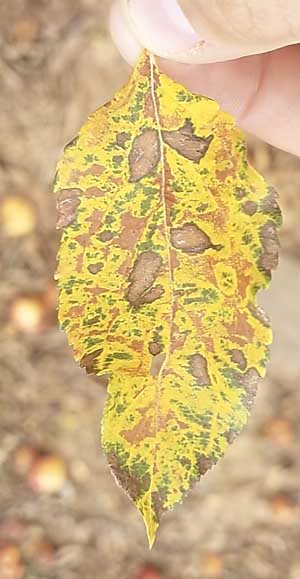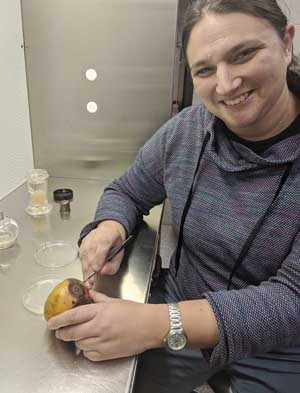
Bitter rot is broken down into two main types in the Eastern United States. The type shown here in a Rome Beauty is more common in the Northeast and Midwest. Typical features include sunken lesions that are marked with small pimple-like structures (acervuli) that are filled with salmon- to orange-colored spores. (Courtesy Sara Villani/NCSU)
In 2018, bitter rot began to rear its head in New York and Michigan apple orchards, but Northeast and Midwest growers have a better chance of fighting it thanks to new research in North Carolina, where the disease had already reached crisis stage.
In fact, North Carolina State University Extension hired apple pathology specialist Sara Villani in December 2015, specifically to focus on bitter rot in the state.
“The growers needed an apple pathologist because they were losing millions of dollars in the state due to this disease — 100 percent crop losses — and not just that, but the losses were coming later in the season, so they also had all of their fungicide inputs, all their pesticide inputs, and all of their labor inputs up until that point,” Villani said.
Since 2015, Villani has not only gained an extensive understanding of the disease but has also conducted studies to determine what works best against it. She presented her results and recommendations at the Great Lakes Fruit, Vegetable and Farm Market Expo in Grand Rapids, Michigan, in December.
Ins and outs of bitter rot
Apple bitter rot is broken down into two main types in the Eastern United States, both of which result from infection with a fungus, according to Villani.
One is more common in the Northeast and Midwest and is associated primarily with the species Colletrotrichum fioriniae.

The other main type of bitter rot in the Eastern United States also goes by the names Glomerella leaf spot and fruit rot. It is more common in the Mid-Atlantic and Southeastern states, although it has recently begun showing up in the Northeast and Midwest. A characteristic of Glomerella is yellowing of the leaves, a symptom that only rarely occurs in the northern form of bitter rot. (Courtesy Sara Villani/NCSU)
Although they share the common name of bitter rot, the northern and southern forms of the disease are distinguishable, she said.
In the northern form, sunken lesions form and are packed with dozens of small pimple-like structures, called acervuli, that are filled with salmon- to orange-colored spores.
In the southern/Glomerella form, the acervuli are usually not present unless humidity is very high, and even then, they are sparse.
Another difference is that the southern/Glomerella form shows leaf-yellowing, whereas leaf symptoms only rarely occur in the northern form.
In terms of cultivar susceptibility, Honeycrisp, Fuji and Granny Smith are highly vulnerable to the northern form of bitter rot, but if conditions are right, “pretty much every cultivar is a target,” Villani said.
The southern/Glomerella form is most damaging to cultivars of Golden parentage, such as Golden Delicious, Gala, Pink Lady, and Jonagold, as well as Granny Smith.
Finding solutions
In 2017 and 2018, Villani and her research group reviewed a range of fungicides on 3 acres of apple trees at the Mountain Horticultural Crops Research and Extension Center in Mills River, which is set in the key apple-growing region of North Carolina. The trees were Tenroy Gala grown on Malling 7 rootstock. Funding for the study came from several agrichemical companies and the U.S. Department of Agriculture Specialty Crop Block Grant.

Sara Villani, North Carolina State University Extension apple pathology specialist, has done extensive work on bitter rot, which has caused millions of dollars in crop losses for apple growers in the state. Her recommendations for controlling bitter rot include using a combination maintenance application, such as ProPhyt and mancozeb/captan, with a post-petal fall spray that contains strobilurin. (Courtesy Rachel Kreis/NCSU)
During the first year of the trial, everything — with the exception of the untreated control trees — received a regular maintenance program of ProPhyt (potassium phosphite) and/or mancozeb/captan until petal fall, followed by 10- to 21-day intervals of bitter rot sprays from petal fall until ninth cover.
A very wet early 2018 — 25 inches of rain from May 15 to May 30 — led the researchers to tighten their bitter rot spray intervals to seven to 10 days that year, and they sprayed from petal fall until 13th cover.
“This was a nonrotational fungicide trial, so we sprayed the same materials, which is highly illegal for (growers) to do, but we needed to see their relative efficacy,” she said.
The fungicides in the trial included thiophanate-methyl, which is “supposed to work better” on the southern/Glomerella form of bitter rot than the northern form; Inspire Super, which is a combination of Group 3 and Group 9 fungicides; Aprovia and Sercadis, which are succinate dehydrogenase inhibitor (SDHI) fungicides; and the fungicides Cabrio and Merivon.
In both years, the best performer against the leaf spotting seen in southern/Glomerella bitter rot was Merivon, a premixed product that includes an SDHI component, as well as a quinone outside inhibitor (QoI) or strobilurin component. She isn’t sure why Merivon outperformed the other sprays, but suspects it might be that the SDHI provided a bit of extra control when combined with possible reduced sensitivity or resistance to QoI fungicides.
In terms of the actual sunken lesions on the fruit, she said anything with a QoI or strobilurin fungicide, or with captan or captan plus ProPhyt did really well. “And what was interesting is that while Aprovia and thiophanate-methyl (resulted in) a lot of spots on the fruit, they really seemed to hold off the rots pretty well,” she said.
In addition, the maintenance application of the ProPhyt and/or mancozeb/captan showed that the combination of the two, applied before petal fall, provided more protection against bitter rot than either did separately.
Take-away for growers
With the results of the two-year trial and added information from North Carolina growers dealing with bitter rot, Villani made the following spray recommendations to orchardists in the Midwest and Northeast who are dealing with either the northern or southern forms of the disease:
—Try a combination maintenance application, such as ProPhyt and mancozeb/captan, with a spray that contains strobilurin, after petal fall.
—When the year is hot and humid, tighten spray intervals, if possible, and add Merivon or something similar, such as Pristine, to the last two applications of the season.
—Watch for strobilurin-resistance, which some North Carolina growers have reported.
“Obviously, chemical control is not going to be the only thing that works,” Villani said. “You need to remove those mummified fruitlets as much as possible. If nothing else, knock them on the ground, but if you can get rid of them, that’s even better because that’s just serving as an inoculum source right in that orchard.”
In addition, growers should remove fruits that are hand thinned, and those that are shed in June drop or near harvest. “I know labor is a huge constraint during those times of year, but anything you can do to try to get some of that inoculum out is going to help,” she said.
Villani provided other steps to fight bitter rot. One is the use of cover sprays that include calcium, which is not only directly toxic to the pathogen but also reduces incidence in the orchard. Another is the removal of fire blight strikes and cankers, where bitter rot can accumulate. That means moving them to the row middle or burning them, she said.
Good pruning habits will increase air movement and therefore reduce humidity. Quick placement of harvested fruit into cool storage conditions will also reduce postharvest rot issues.
In addressing the crowd of mostly Michigan growers at GLEXPO, she said, “Apparently, this year there’s been more and more (northern) bitter rot on your trees. The Glomerella leaf spot and fruit rot were more of a southern-region disease, but now it’s coming more and more to the North — I know New York has detected it a few times — so if you don’t have it yet, it may just be a matter of time.” •
—by Leslie Mertz






Leave A Comment